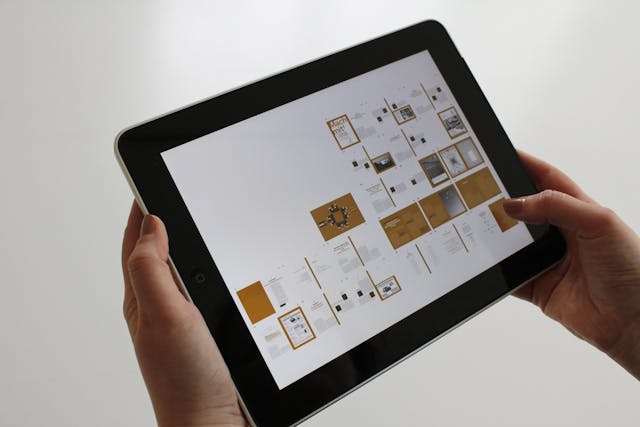Using Low-Cost Immersive 360° Video Technology to Enhance Core Skills in Journalism Classes
Introduction
While immersive media, such as Virtual Reality (VR) and associated 360° video technologies, have been around for decades, their availability to consumers has increased dramatically since 2016. The rising availability of immersive technological tools, ranging from low-cost VR viewer headsets to higher-end, more costly devices such as the Oculus and HTC Vive, has boosted VR adoption in education (Hayes et al., 2021; Kaplan-Rakowski & Meseberg, 2019, Lindgren et al., 2016). The most popular of these immersive experiences are 360° films that can be seen with a low-cost VR viewer headset, with Google alone distributing over 15 million of these devices (Chen, 2019). These 360° experiences provide spatial realism and the ability to “look around” in the virtual environment.

This affordance is directly related to the experience of presence or “being there” in the virtual space, which is linked to embodiment and immersion. This experience allows users to digitally interact with locations that are normally impossible to reach (e.g., inside a jail), hazardous (e.g., war zones), or isolated (e.g., a desolate island) (Bailenson, 2018). These features are consistent with 21st-century basic journalism abilities such as critical thinking (Ferrucci, 2018), empathy, and perspective taking (Eekhof et al., 2021). Furthermore, 360° technology allows users to view persons or places in a realistic way that would otherwise be hard to do, which aligns with the development of key journalism skills such as empathy and perspective taking (Glück, 2016). Glück explicitly mentions empathy as an underappreciated virtue among journalists. Given the widespread belief that VR is the “ultimate empathy machine,” it is an essential tool to investigate for journalism education.
Journalism Education, Immersive 360° Video
360° videos, unlike traditional 2D videos, allow users to look in any direction within the experience, resulting in increased agency and empathy for the subjects depicted (de la Peña, 2017; de la Peña et al., 2010; Shin, 2017). 360° films provide strong narrative experiences (Shin, 2018), which appeal to the profession of journalism, where storytelling is essential. Immersive media producers aspire to create first-hand VR experiences that increase empathy and may influence attitudes and actions (de la Peña et al., 2010; de la Peña, 2017).
Existing study has looked at how immersive journalism affects the feeling of presence and credibility of its experiences (Kang et al., 2019), user perceptions (Sundar et al., 2017), and emotional involvement (Kukkakorpi and Pantti, 2020; Uskali and Ikonen, 2020). Similarly, studies have shown that immersive journalism may effectively engage readers in an immersive, sympathetic experience (Archer & Finger, 2018; Soler-Adillon & Sora, 2018). However, these research are mostly confined to ‘in the field’ applications outside of higher education.
Pedagogical insights into the use of immersive media in journalism education are mostly theoretical (Pavlik, 2020; Sissons & Cochrane, 2019). The purpose of this research is to overcome some of these limitations and add to the literature by demonstrating how journalism students use immersive technology to enhance their emotional learning. Similarly, challenges to successful instructional design often include a lack of training in how to handle immersive media technology, much alone construct instructional material around it (Alfalah, 2018; Khukalenko et al., 2022). The project presented in this pilot research also sought to assist professors with the introduction of immersive technologies.
The logical fit of immersive media to journalism and journalism education becomes increasingly obvious as big news companies and developers, like CNN and Google, engage in the medium. The School of the New York Times offers an online VR diploma, which adds to the validity of immersive technology as a source of journalistic output. The usefulness of VR for journalistic purposes is connected to its potential to provide immersive narrative that engages viewers more profoundly than conventional 2D media (Gynnild et al., 2020).

Pedagogy and Immersive Media Usability.
Certain VR technologies that may be used to watch 360° media and participate in highly interactive experiences will cost more than $2000 per device by 2022 (for example, HTC Vive and high-end PC). Meanwhile, for this pilot research, we employed an inexpensive VR viewer (Google Cardboard), which costs about $10 per unit. These less priced viewers work by plugging cellphones into the headgear, allowing users to immerse themselves in 360° activities. Given their affordability and immersive media capabilities, the major purpose of this study is to investigate journalism students’ responses to these 360° experiences. Many instructional design decisions must be made with the device’s special usability characteristics in mind, such as the availability and simplicity of use of cardboard viewers, which enable instructors with even little assistance to equip modestly sized classrooms with the tools. Furthermore, public networks like YouTube provide free 360° movies that teachers may incorporate into their current course material or create new activities and educational experiences.
CAMIL, 360° Video, and Journalistic Learning Outcomes
While there are several models and frameworks for integrating media into curriculum, such as multimedia learning theory (Mayer, 2002), most models fail to address the special affordances and pedagogical needs associated with the integration of immersive technology. While immersive media provides users with medium-specific characteristics tailored to certain forms of learning, much of the fundamentals of learning from and deploying it in schools may be generalized from conventional media (Makransky & Petersen, 2021). Specific aspects of immersive media (such as 360° video) impact how students engage with and eventually learn from their experiences.
Makransky and Petersen’s (2021) Cognitive Affective Model of Immersive Learning (CAMIL) proposes that increased presence and agency in an immersive experience are linked to mental factors that influence successful learning, such as interest, motivation, self-efficacy, embodiment, cognitive load, and self-regulation. Immersive 360° films in journalism are not meant to replace conventional instructional methods (e.g., lectures), which are often more successful for teaching declarative information (Bailenson, 2018; Hayes et al., 2013; Herrera et al., 2018; Van Loon et al., 2018). Instead, such films may help students practice the emotion-driven interpersonal skills required for a comprehensive journalism education.
CAMIL supports instructional designers in structuring immersive VR classes that take use of the technology’s unique capabilities. The approach directs designers to consider how the experience of presence and agency may be utilized to boost student embodiment, which is thought to promote factual and conceptual learning. Instructional design teams should consult with subject matter experts (SMEs) to determine the desired learning objectives and immersive material. This strategy enables the educator to structure lectures, pre-select immersive material, and lessen cognitive burden. CAMIL also emphasizes the significance of reflection in improving metacognition and learning outcomes (Makransky & Petersen, 2021).
Makransky and Peterson (2021) describe immersive VR as experiences accessible via a VR headset. This difference is crucial since the degrees of immersion differ between 360° films and more intense VR realities. 360° video technology allows for minimal interactivity since it is often restricted to pre-recorded visual and audio information that users cannot change. The versatility of 360° video viewing modes more than compensates for the restricted interaction. That instance, a 360° movie may be seen in a low-cost headset or on a regular flat-screen monitor, depending on students’ choices and availability to VR equipment.
Purpose of Study
The goal of this research was to look at the effect of immersive, 360° video on the instructional design of a journalism course, as well as how incorporating 360° video experiences affected critical journalism skill development, such as empathy and perspective taking. The research questions (RQs) were:
RQ1: How does the usage of inexpensive 360° video footage affect the development of human abilities in journalism, such as empathy and perspective taking?
RQ2: What are the instructional design implications of 360° video material in journalism courses?
Methods
Participants
Ten students enrolled in an undergraduate journalism course titled Covering Crisis, Trauma, and Recovery at a prominent public institution in the Southern United States. The sample comprised mostly of journalism majors aged 19 to 27 with an equal gender distribution. Students were given informed permission at the start of the course, with the opportunity to opt out of participation without penalty.

Procedure
Before the semester began, researchers collaborated with a subject matter expert (SME), an experienced journalism teacher, to investigate how immersive technology may help to the learning goals of journalism programs. For our pilot research, we selected “Covering Crisis, Trauma, and Recovery” as the class that the SME believed would benefit from immersive experiences. After examining the current course, its learning goals, and the learning opportunities provided by immersive learning experiences, we determined the target journalistic skills: empathy and perspective taking. We then went through a collection of existing 360° movies and presented them to the teacher to see which ones would be most suited to include into the overall course design. Three 360° movies were chosen for their potential to build emotional connections in students after exploring several databases of experiences that are publicly accessible to educators.
Because the teacher and students were new to VR, the first movie (a simulation of swimming with sharks) acted as a training exercise to get them acquainted to utilizing 360° video technology. The second experience was Send Me Home, which tells the tale of Rickey Jackson, a Black man unfairly imprisoned for 40 years for a crime he did not commit. The 15-minute experience follows Jackson as he muses on his past and destiny while walking through the real jail in which he formerly stayed. The final film, The Art of Healing, features Miriam Cortez, an artist born to illegal immigrants who uses art to express herself and recover from her painful history. Interestingly, Cortez created art works that were designed to be seen in 360°, as a way of connecting the audience to herself. Our teacher chose these experiences based on their ability to elicit empathy from viewers for their victims’ prior suffering (a course topic) in an immersive, sensory-engaging manner.
Each student utilized a low-cost 360° video viewer, Google Cardboard. The experiences were presented in two separate sections, roughly two weeks apart. A trained research assistant introduced students to the experiences by teaching how to use the headsets and facilitating conversation after the sessions. To minimize motion sickness, students have the option of viewing 360° films on a flat screen monitor rather than utilizing VR viewers. However, all pupils opted to utilize VR viewers. As per the CAMIL approach, students were given the chance to debate both the mechanics and the content of the movie as a group, since reflection is essential for metacognition and deeper learning. During the target weeks, students wrote an expressive journal entry on what they learnt and how the 360° films related to that learning.
Data analysis
A thematic analysis was employed to examine students’ diary entries on watching the immersive 360° experiences. We evaluated and analyzed all of the students’ 23 reflective diary entries using a thematic analysis method, a qualitative data analysis technique that strives to discover patterns, meaning, and overarching themes in open-ended data to answer research questions (Braun & Clarke, 2006).
During theme analysis, at least two coders read each journal item. This theme analysis was based on the CAMIL framework (presence, novelty) and learning goals (empathy and perspective-taking). During the investigation, the team classified aspects such as overall emotional effect, utility, perspective taking, novelty, engaging with VR, and VR usefulness. This method was carried out in NVivo, with coders round-tabling findings until satisfactory interrater reliability (k >.80) was attained.






